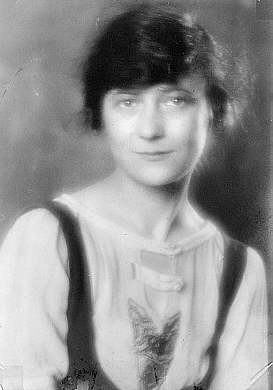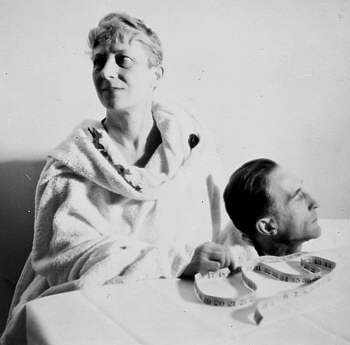
Man Ray
(Emmanuel Radnitzky)
(American, 1890–1977).
Mary Reynolds, 1930. 



Page 1 of 4
Warm Ashes: The Life and Career of Mary Reynolds
 Download PDF of entire essay for printing (1282k). Download PDF of entire essay for printing (1282k).
OTHER ESSAYS
Mary Reynolds: From Paris to Chicago to the Web
Documents of Dada and Surrealism: Dada and Surrealist Journals in the Mary Reynolds Collection
Hans Bellmer in The Art Institute of Chicago: The Wandering Libido and the Hysterical Body
|
|
Warm Ashes:
The Life and Career of Mary Reynolds
SUSAN GLOVER GODLEWSKI
Boston, Massachusetts
By nature a modest, self-effacing woman who preferred being in the background, Mary Reynolds nonetheless found herself at the center of the Surrealist movement, as both artist and advocate. As the artist Marcel Duchamp described her, she "was an eye-witness of the Dadaist manifestations and on the birth of Surrealism in 1924.... [and] was among the 'supporters' of the new ideas. In a close friendship with André Breton, Raymond Queneau, Jean Cocteau, Djuna Barnes, James Joyce, Alexander Calder, [Joan] Miró, Jacques Villon, and many other important figures of the epoch, she found the incentive to become an artist herself. She decided to apply her talents to the art of bookbinding."[1] The bindings preserved in the Mary Reynolds Collection at The Art Institute of Chicago are an eloquent testament to her significance as an artist.
Duchamp was a key influence on Mary Reynolds's life and art. For nearly three decades, Reynolds and Duchamp enjoyed a union that was "thought by their friends to be happier than most marriages."[2] From the late 1920s on, Duchamp had two addresses in Paris: his own small apartment on rue Larrey and Reynolds's house on rue Hallé. He had long before stopped making art publicly, but continued to be immersed in the "new forms of rebellion" that would lead to Surrealism. Reynolds joined him in this activity, and it is the resulting Surrealist vocabulary, with its wit and surprise, that most informs her work.
Early Life: 1891–1921
Mary Louise Hubachek Reynolds was born in 1891 in Minneapolis into a well-to-do family; her father, Frank Rudolph Hubachek, was a lawyer; and her mother, Nellie Brookes Hubachek, a homemaker. Educated in Minneapolis public schools, Mary Hubachek went east in 1909 to attend Vassar College, from which she received her Bachelor of Arts degree in 1913. By all accounts, "Mary Hub," as her college friends referred to her, was "a lovely person...so gentle and...she had many friends among us."[3]

Mary Reynolds, late 1910s or early 1920s.
After graduation, she moved back to Minneapolis, where she took postgraduate courses at the University of Minnesota. Her only sibling, brother Frank Brookes Hubachek, was also a student there at the time. They had been close since childhood. Brookes, as he was known, acknowledged in 1963, "While it would doubtless be difficult for an observer to agree, Mary and I were cut from the same cloth."[4] Their mutual affection and respect only grew through the years.
During this period, Mary Hubachek met Matthew Givens Reynolds, the son of a St. Louis judge. Not much is known about their courtship; however, it must have progressed swiftly from casual dating to a serious relationship. The two were married at her family's country home on July 24, 1916. The marriage was a happy one; they were perfectly suited to each other and very much in love. During their engagement, Matthew Reynolds had accepted a position with an English insurance company that specialized in ocean shipping, and he moved to New York. After the wedding, the couple settled in Greenwich Village, the center of Bohemian life in the United States at the time. Populated by artists, writers, designers, and nonconformists of all types, the Village was exciting, energetic, and a slightly dangerous place with much to amuse the young couple. This free and easy, spirited living appealed to Reynolds, who clearly was trying to break free of the orthodoxy of her upbringing and define herself. People and situations that some would have found shocking, Reynolds found exhilarating.
When the United States entered World War I, Matthew Reynolds enlisted. Commissioned in November 1917, he left for the front a mere sixteen months after his wedding day. Reynolds commanded a battery of field artillery with the famous 33rd Wildcat Division, which was instrumental in breaking through the Hindenburg line, a turning point in the war. Although he survived the horrors of trench warfare, Matthew Reynolds died of influenza on January 10, 1919. His widow was devastated. She stayed with a close friend from Vassar, Elizabeth Hilles, for a time after receiving the dreadful news. Hilles, who considered Mary Reynolds one of her "dearest and closest friends," remembered Reynolds "was struggling with the problem of the future, and I felt that she would never recover from her loss. She said one day, 'Bess, you can fill your life with causes, but I can't. I've never cared for anything but people, and all my dreams were fulfilled in Matthew. Now my life is empty.'"[5]
Reynolds briefly returned home to Minneapolis, but it was not a happy visit.[6] Her parents were determined that she should get on with life, remarry, and begin a family. She was equally as determined to chart her own course. Matthew Reynolds had embodied all of her dreams. She could not simply move on so soon to a life without him. This falling out with her parents was serious and propelled her back to New York and shortly thereafter to Paris. As was true of many war fatalities, Matthew Reynolds's body was not sent home for burial. Consequently, his widow felt the need to travel to Europe, where he had spent his final year, to be close to his spirit. For Reynolds, this was a way of emancipating herself from the unbearable expectations of home as well as confronting her loss. The move was to be a pivotal change in her life. The writer Janet Flanner, Reynolds's intimate friend, noted that Reynolds became "part of the colony of about 5,000 Americans to whom Paris...seemed liberty itself." [7]
The Early Paris Years
In April 1921, Reynolds arrived in Paris, settling in Montparnasse, a community that reminded her of Greenwich Village. Duchamp reminisced that "Montparnasse was the first really international colony of artists we ever had. Because of its internationalism, it was superior to Montmartre, Greenwich Village, or Chelsea."[8] Reynolds quickly came to know many of its most interesting residents. She became a fixture on the party circuit, even introducing the artist Man Ray and the composer Virgil Thomson to each other in 1921, shortly after they had each arrived from New York.[9]

Man Ray. Mary Reynolds, c. 1925–1935.
When the American socialite Peggy Guggenheim, Reynolds's close friend, married novelist, poet, and painter Laurence Vail in 1922, the Paris avant-garde was stunned. Everyone had assumed that Reynolds and Vail were engaged to each other.[10]
It was probably as a result of her relationship with Vail that Reynolds gained access so quickly to the café society. Vail was known variously as the "King of Montparnasse" or the "King of Bohemia." The American literary critic Malcolm Cowley recalled: "Laurence was in the center of things. If you knew anyone, you knew Laurence."[11] Vail introduced Peggy Guggenheim to both Reynolds and the writer Djuna Barnes, another of his entourage. All three became close, lasting friends. Guggenheim described Reynolds and Barnes as being among the most outstanding beauties of Montparnasse: "They [each] had the kind of nose I had gone all the way to Cincinnati for in vain."[12]
Reynolds and Duchamp initially met in New York when both were living in Greenwich Village. They renewed their acquaintance in Paris in 1923, spending considerable time socializing at the Boeuf sur le Toit and other cafés while their involvement deepened. The relationship did not run smoothly, however, for Reynolds. Duchamp cherished his freedom and his unconventional, even shocking, life. He insisted that their relationship be kept secret. If they ran into each other in public, Reynolds was not to acknowledge him. Duchamp continued to see others and expected her to do the same (she did not). This created tremendous conflict for her that took its toll. Reynolds began to drink excessively.[13] She finally confirmed in 1924 to writer and critic Henri-Pierre Roché, one of Duchamp's most intimate friends, that Duchamp was, indeed, her lover, but lamented his lack of fidelity and continued attraction to "very common women."[14] She suspected Duchamp was "incapable of loving" and unable to commit to one person. Some twenty years later, the wife of the sculptor Antoine Pevsner spoke of meeting Reynolds when Peggy Guggenheim brought her unexpectedly to dinner. "We were amazed," recalled Virginia Pevsner, "to learn that Mary had been with Marcel Duchamp for nearly 20 years. During that time, Pevsner had seen Duchamp 2 or 3 times a week and Marcel had never said a word."[15] Beatrice Wood captured this part of Duchamp's character most closely when she stated, "Everybody loves him. He belongs to everybody and to nobody."[16]

Man Ray. Photograph of Mary Reynolds and Marcel Duchamp. Gelatin silver print; 15 x 14.9 cm. The Art Institute of Chicago, Gift of Frank B. Hubachek (1970.796). Though Duchamp remained an enigma to most, he and Reynolds seem to have found their common ground after Duchamp's short-lived marriage to Lydie Sarazin-Levassor in 1927. Duchamp finally relented and allowed their relationship to become public. He later described it as "a true liaison, over many, many years, and very agreeable"; although he did qualify it by remarking that they "weren't glued together, in the 'married' sense of the word."[17] Although they never married, from 1928 until the Nazi occupation of Paris separated them, Reynolds and Duchamp were seen together, lived together, vacationed together. In her memoirs, Peggy Guggenheim wrote: "Every time Mary was asked why she didn't marry Marcel, she would say Marcel didn't want to. Every time Marcel was asked, he would say Mary didn't want to."[18] There was probably some truth in each statement. Reynolds wore her wedding band from her marriage to Matthew Reynolds her entire life. It appears that, in some way, Reynolds was just as unavailable to Duchamp as he was to her.



 Next > Next >
Page 1 of 4
Warm Ashes: The Life and Career of Mary Reynolds
OTHER ESSAYS
Mary Reynolds: From Paris to Chicago to the Web
Documents of Dada and Surrealism:
Dada and Surrealist Journals in the Mary Reynolds Collection
Hans Bellmer in The Art Institute of Chicago:
The Wandering Libido and the Hysterical Body
Essays | Works of Art | Book Bindings | Related Sites | Finding Aid | Search Collection
|
|
